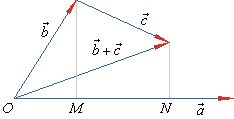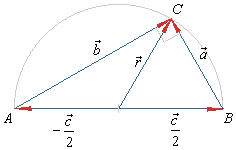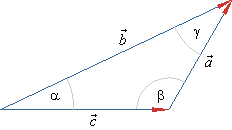|
|
|
|
ALGEBRA
|
|
|
|
::
Scalar product or dot
product or inner product
|
|
The word scalar derives from the English
word "scale" for a system of ordered marks at fixed intervals used in measurement, which in turn is derived
from Latin scalae - stairs. |
| Physical quantities like, distance, time, speed, energy, work, mass and so on, which have magnitude but no direction, are called scalar quantities or scalars.
Thus, the magnitude of any vector is a scalar. |
|
|
|
|
Perpendicularity (or
orthogonality) of two vectors
|
| Therefore, if the scalar product of two vectors,
a
and b
is zero, i.e., |
| a ·
b
= 0
- then the two vectors are orthogonal. |
| And inversely, if two vectors are perpendicular, their scalar product is zero. |
 |
|
|
The value of the scalar product of two vectors depends
on their position
|
| Different positions of two vectors and the corresponding values of their scalar product are shown in
the below figures. |
|
|
 |
 |
 |
 |
|
|
Square of magnitude of
a vector
|
| The scalar product of a vector with itself,
a ·
a
= a2
is the square of magnitude of a vector, that is |
 |
| thus, |
 |
-
in the coordinate plane, and |
 |
-
in 3D space. |
|
|
Scalar product of unit
vectors
|
| The unit vectors,
i,
j and k,
along the Cartesian coordinate axes are orthogonal and their scalar products |
 |
and |
 |
|
|
|
Scalar or dot product
properties
|
| a)
k
· (a · b)
= (k · a) · b
= a · (k · b),
k
Î
R |
| b)
a
· b = b · a |
| c)
a
· (b + c)
= a · b + a
· c |
| d)
a
· a = a2
= | a |2 |
|
 |
|
| According to the definition of the dot product, from the
above diagram, |
 |
then |
|
 |
what confirms the distribution law. |
|
| The associative law does not hold for the dot product of more vectors, for example |
| a
· (b · c) is not equal
(a
· b) · c |
| since
a
· (b · c) is the vector
a
multiplied by the scalar b
· c,
while (a
· b) · c
is the vector c
multiplied by the scalar a
· b. |
|
|
Scalar product in the
coordinate system
|
| The scalar product can be expressed in terms of the
components of the vectors, |
 |
| thus, |
 |
- the scalar product in three-dimensional coordinate system, |
|
|
 |
- the scalar product in the coordinate plane. |
|
|
|
Angle between vectors
in a coordinate plane
|
| From the scalar product
a
· b = |
a |
· | b | · cosj
derived are, the angle between two vectors, formulas |
|
for plane vectors |
|
for space vectors |
|
|
|
|
|
The cosine of the angle between two vectors,
a
and b
represents the
scalar product of their unit
vectors,
|

|
|
|
|
Scalar
product of vectors examples
|
|
Example:
Applying the scalar product, prove Thales’ theorem which states that an angle inscribed in a semicircle is a right angle.
|
|
Solution: The right figure
shows that |
 |
 |
| since square of a vector equal to square of its length, |
|
 |
|
 |
| therefore
a
and b are
perpendicular vectors as
a
· b = 0. |
|
|
Example:
Prove the law of cosines used in the trigonometry of oblique triangles.
|
|
Solution: Assuming the directions of vectors as in
the right diagram
|
 |
Using the scalar product and substituting square of vectors
by square of their lengths, obtained is |
| a2 =
b2 + c2 -
2bc · cosa
- the law of cosines. |
| In the same
way, |
|
 |
|
 |
|
|
Example:
Determine a parameter l
such that the vectors,
a
= -2i
+ l
j
-
4k
and b
= i -
6 j + 3k
to be perpendicular.
|
|
Solution: Two vectors are perpendicular if their scalar product is zero, therefore |
 |
|
|
::
Projection of a vector in the direction of another vector,
the scalar and vector components
|
|
The scalar
component
|
| The length of projection of
a
in the direction of
b
or the scalar component ab,
from the diagram, |
|
|
|
Thus, the scalar component of a vector
a
in the direction of a vector b
equals the scalar product of the vector
a
and the unit vector b0
of the vector
b.
|
|
|
The vector component
|
|
By multiplying the scalar component
ab, of a vector
a in the direction of
b, by the unit vector
b0
of the vector
b, obtained
is the
vector component
of a in the direction of
b.
|
|
|
|
|
|
|
|
|
|
|
|
|
|
|
|
|
|
|
|
|
|
|
|
|
|
|
|
|
|
|
Contents
B
|
|
|
|
|

|
|
|
|
|
|
Copyright
© 2004 - 2020, Nabla Ltd. All rights reserved.
|
|
|